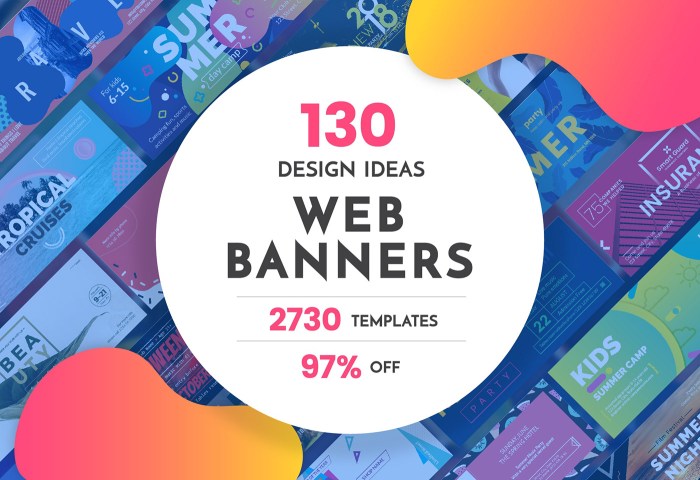Designing Effective Web Banners dives deep into the art of creating captivating online banners to grab your audience’s attention and drive engagement. Get ready to explore the world of web design like never before!
From understanding the key elements to mastering design principles and best practices, this guide has got you covered. Let’s elevate your banner game to the next level!
Understanding Web Banner Design

Web banners play a crucial role in digital marketing as they serve as a visual representation of a company’s brand, products, or services. They are designed to grab the attention of the target audience and drive traffic to the website.
Key Elements of Effective Web Banner Design, Designing Effective Web Banners
- Eye-catching visuals: Use high-quality images or graphics that are visually appealing and relevant to the message you want to convey.
- Clear call-to-action: Include a compelling call-to-action button that prompts users to take the desired action, such as clicking through to the website.
- Concise and impactful copy: Keep the text short and to the point, focusing on the key message or offer you want to communicate.
- Consistent branding: Ensure that the web banner design aligns with the overall branding of the company to maintain brand recognition.
Examples of Successful Web Banner Campaigns
- In 2019, Nike launched a web banner campaign featuring professional athletes wearing their latest footwear collection. The eye-catching visuals, clear call-to-action to shop the collection, and consistent branding elements made this campaign highly effective.
- Coca-Cola’s holiday-themed web banner campaign in 2020 used festive imagery, a compelling call-to-action to share joy with loved ones, and concise copy to encourage engagement. The campaign generated high click-through rates and increased brand visibility during the holiday season.
Design Principles for Web Banners

When creating web banners, it is essential to consider fundamental design principles that can help make your banners more effective in capturing the attention of your target audience. From color theory to typography choices, each design element plays a crucial role in the success of your web banners.
Color theory is a powerful tool that can greatly impact the effectiveness of a web banner. Different colors evoke different emotions and reactions from viewers. For example, warm colors like red and orange can create a sense of urgency or excitement, while cooler tones like blue and green can convey calmness or trust. It’s important to choose colors that align with your brand and message to ensure maximum impact.
Typography choices also play a significant role in enhancing the message of your web banners. The font style, size, and spacing can all affect readability and visual appeal. Make sure to choose fonts that are easy to read, especially at smaller sizes commonly used in web banners. Additionally, consider using bold or italic styles to emphasize key messages and ensure that the text stands out against the background.
Tips for Effective Typography Choices
- Choose readable fonts that align with your brand.
- Ensure proper spacing between letters and lines for better readability.
- Use bold or italic styles to emphasize important information.
- Avoid using too many different fonts in one banner to maintain a cohesive look.
Best Practices for Web Banner Design: Designing Effective Web Banners
When it comes to designing web banners that drive engagement, there are several best practices to keep in mind. From responsive design to clear Call-to-Actions (CTAs), each element plays a crucial role in the success of a web banner campaign.
The Importance of Responsive Design
Responsive design is essential in today’s digital landscape where users access websites and content on various devices with different screen sizes. Ensuring that your web banners are responsive means they will adapt and display correctly on desktops, laptops, tablets, and smartphones. This not only improves user experience but also increases the chances of engagement and conversions.
- Make sure your web banners are designed using a mobile-first approach to prioritize the user experience on smaller screens.
- Test your web banners across different devices and browsers to ensure consistent performance and display.
- Optimize images and content for fast loading times on all devices to prevent users from bouncing due to slow loading speeds.
The Significance of Clear Call-to-Actions (CTAs)
A clear Call-to-Action (CTA) is crucial in guiding users on what action to take after viewing your web banner. Whether it’s to shop now, learn more, sign up, or download, a well-defined CTA can significantly impact the success of your campaign.
- Use action-oriented words that create a sense of urgency and encourage users to click, such as “Shop Now,” “Learn More,” or “Get Started.”
- Place the CTA prominently on the web banner, making it easily accessible and visible to users.
- Ensure that the CTA stands out from the rest of the design elements with contrasting colors, bold fonts, or strategic placement.
Tools and Software for Designing Web Banners
When it comes to creating eye-catching web banners, having the right tools and software is essential for a smooth design process. Let’s explore some popular options and how to make the most out of them.
Popular Design Software for Web Banners
- Adobe Photoshop: Known for its versatility and powerful editing capabilities, Photoshop is a go-to choice for many designers. It offers a wide range of tools for creating stunning web banners.
- Canva: Ideal for beginners and non-designers, Canva provides a user-friendly interface with pre-designed templates and drag-and-drop functionality.
- GIMP: An open-source alternative to Photoshop, GIMP is a free software that offers advanced editing features for designing web banners.
Tips for Leveraging Design Tools
- Explore tutorials and online resources to familiarize yourself with the features of the design software you choose.
- Utilize templates and presets to speed up the design process and maintain consistency in your web banner designs.
- Experiment with different tools and effects to create unique and visually appealing banners that stand out.
- Consider using graphic design plugins or extensions to enhance the functionality of your chosen design software.


